Sun-Moon Alignment - A Geometric Treatment
Roger said that his interest had been re-awakened when he happened to notice a near-first-quarter Moon when sitting in his garden enjoying a cup of tea (as one does!). He took a quick snap with a pocket camera and, having enlarged it, saw that the Moon clearly did not point at the Sun, which was also visible off to the West. To illustrate the point, he took several individual shots covering the span of the sky between the two and used a software program to stitch them together into a panorama. Overlaying this panorama with increased-size versions of Moon and Sun (necessary because the two are very small in the sky at the scale needed to show a full panorama) he produced an image showing the "Moonpoint" conundrum very clearly. He was not done yet though! Using another program, he "warped" the panorama into a regular curve and, lo and behold, the Moon did now point directly at the Sun.
The sequence is shown below in the form of images:-
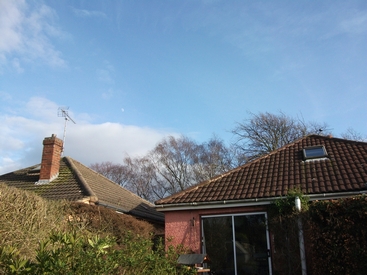 |  |
| Firstly, the original photograph. The Moon is rather hard to find, but is located just above the cloud-bank to the right of the television aerial. An enlarged version is given on the right, showing that the illuminated segment of the Moon is definitely pointing somewhat upwards. |
 |
| Now take a series of photographs and stitch them together into a panorama. |
 |
| Next, overlay enlarged versions of Moon and Sun. This shows very clearly that the illuminated segment of the Moon is not pointing directly at the Sun. |
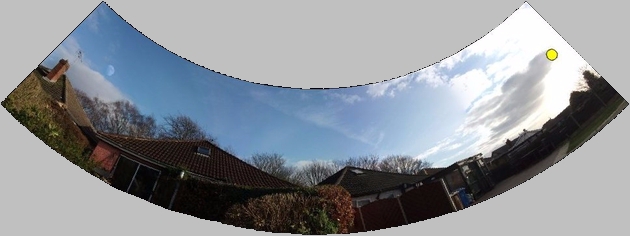 |
| Finally, warp the panorama into a segment of a circle. The Moon now does point at the Sun! |
| This is all very well but what is it telling us? To shed some light on this Roger remembered a "blast from his past" (and mine too!) in the form of a little book titled 'I‑Spy The Sky'. The I‑Spy series were essentially "spotters' guides", encouraging children to go out and observe the world around them and covered many subject areas such as birds, cars, aircraft, bridges etc. In order to show the position of objects in the night sky, I‑Spy The Sky used a simple black disc, where the centre of the disc represented the point in the sky directly above the observer's head. The top edge represented the northern horizon, with south at the bottom, east to the left and west to the right: note that this is the reverse of the normal "compass" directions of east and west because the disc was intended (notionally at least!) to be viewed as if it were placed above the observer's head, facing downwards. A typical page is shown on the right - note the "I‑SPY score". If you gained enough points in a book you could apply for an Order of Merit! I‑Spy The Sky was not the only publication to use this representation of course - it was then and still is now commonly used in many print publications, and is also the standard format used on the Internet - but it was the one that set Roger thinking. | 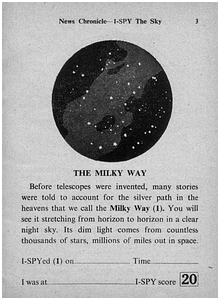 |
The "sky-disc" is simply a 2-dimensional representation of the 3-dimensional "dome of the heavens", created by projecting each point on the dome down onto its base. However, this process will cause the inner surface of the dome (i.e. what we perceive as the surface onto which the stars are fixed and across which the Sun, Moon and planets move) to be distorted as it becomes a disc, losing its third dimension. Looking at it the other way round, if we wanted to stick Roger's panorama onto the inner surface of a bowl we would not only have to curl it round into a cylinder but would also have to bend the top part inwards to follow the curve of the bowl. This could not be done without either cutting sections out at the top or folding and overlapping the top part. The result would be that if the panorama were then to be removed from the bowl one would find that the originally straight panorama strip had acquired an upwards curve. Roger's warping operation performed the "bowl fitting" operation digitally, allowing the panorama to be fitted into a dome of the heavens. The fact that this also resulted in the Moon pointing directly at the Sun shows that once the "depth" dimension missing from a straight panorama is restored in this way, the true situation is revealed. We don't see the true situation because, as we can't see all of it at once, our eyes flatten out the dome of the heavens, removing the depth dimension and distorting the panorama back into a straight strip.
The fact that the curved panorama fits nicely onto a sky-disc whereas a straight one would not can be easily shown. I've taken an image from the Heavens Above website which has a similar configuration of Moon and Sun as Roger observed (bottom half only shown for convenience). A suitably scaled and rotated image of the outline of his curved panorama overlays the image perfectly:-
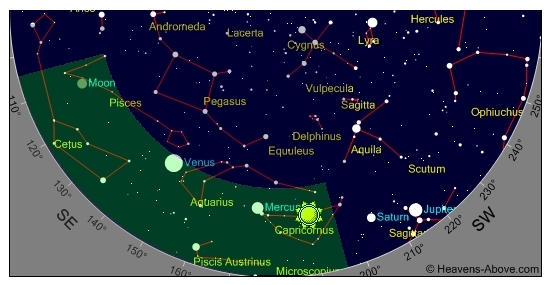
This shows that the warping operation is not a "fiddle" to get the image to show what this article has been saying (that the Moon really does point directly at the Sun, no matter what our eyes might be telling us), but is actually necessary in order to allow for the difference in visual perception when a 3-dimensional "dome of the heavens" is seen as a 2-dimensional "sky disc".
This perceptual distortion when moving from three dimensions to two also manifests itself in other ways. A particularly clear example is given by the visual appearance of transits of artificial satellites across the sky - the most well-known of which is of course the International Space Station (ISS). This travels in a near-circular orbit about 250mls (400km) above the Earth's surface and can often be seen crossing the night sky as a very bright and fast-moving star. Predictions of such transits are given by many websites, including Heavens Above.
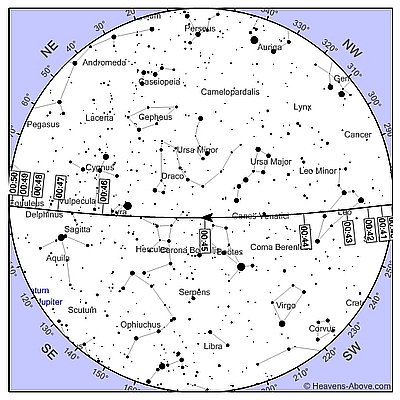 | This diagram from Heavens Above, which plots the position of the ISS on a sky-disc every minute as it rises in the West (to the right of the sky-disc), crosses almost through the local zenith and sets in the East, shows a typical ISS transit. Note that at the beginning of the track the position marks are closely spaced, showing that close to the western horizon the ISS is hardly moving across the sky. The marks then spread out, indicating an increase in speed, before being very well spaced at the zenith, the position of maximum velocity. The marks then close up again, showing that the ISS slows when approaching the eastern horizon before being very close together once more as it slowly sets. But how can this be? The ISS moves along its orbit at a constant speed and therefore should surely be seen crossing the sky at a similarly constant rate. However, this diagram shows that it moves very slowly when rising above the local horizon, speeds up as it climbs higher, zooms across the zenith, slows down again as it descends, and finally disappears from view at a very leisurely pace. Anyone who has observed the ISS will know that this is definitely exactly what happens. So what's going on? |
As with the Moonpoint effect, the answer lies in the geometry. The ISS is traversing a 3-dimensional space (the dome of the heavens) but we are observing it as if it is crossing a 2-dimensional sky-disc. Although not an exact representation of the situation, this diagram shows the essence of what is happening:-
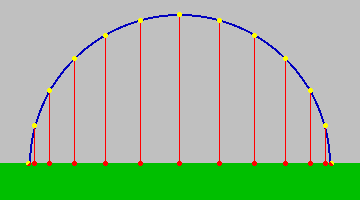 | The blue curve represents a vertical cross-section through the dome of the heavens, upon which yellow discs have been placed at equal 15degree intervals to represent the ISS crossing the sky at constant speed. The red lines and discs project the position of the ISS at equal times onto the sky-disc represented by the straight edge of the green area at the bottom. It is clear that the red discs are bunched up close to the horizon points and spread out as the zenith is approached, exactly as for the ISS track. The loss of the 3rd dimension (depth into the dome, or height on this diagram) has distorted the constant actual speed of a moving item into a variable "as observed" speed. |
We thus see that the way we observe the heavens heavily influences the way we believe the heavens "really are". Unfortunately, although seeing might be believing it does not always tell the truth!








